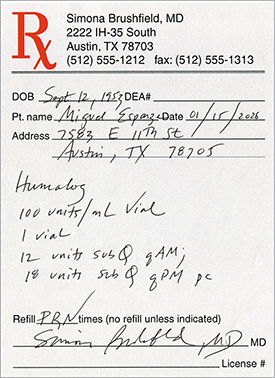3.1 What Is a Drug?
Laypeople generally think of drugs as only those substances manufactured by a pharmaceutical drug company for their medicinal effects, or narcotics that can be easily abused.
However, all drugs fall into one of three broad categories as designated by the FDA: prescription, over-the-counter (OTC), and homeopathic.
A prescription drug, formerly known as a legend drug, is a drug that can be legally dispensed to a patient only upon the receipt of a state-licensed healthcare provider’s directive via an e-prescription (online electronic prescription) or a handwritten, faxed, or authorized verbal prescription. Consequently, all prescription drugs are labeled with the legend “Rx” (see Figure 3.1).
Figure 3.1 Sample Prescription
A handwritten prescription should contain all the necessary information for the technician and pharmacist to fill it, and it should be signed by the provider. Most prescriptions are now e-prescriptions, but they still require the same elements.

The prescription must have the provider’s name, address, phone number, date written, and signature to be considered legal. The 10-digit National Provider Identifier (NPI) is often included for insurance purposes, and, for all controlled prescriptions, especially Schedule II drugs, the prescriber’s Drug Enforcement Administration (DEA) number is required. This information, along with the patient’s name, address, and date of birth, and the drug’s name, dosage, duration, and prescribing date are all key parts of a prescription (see Figure 3.1). These elements will be covered in greater detail in the section on community pharmacy dispensing in Chapter 7.
An over-the-counter (OTC) drug is a medication that may be sold without a prescription. A homeopathic product uses minute dilutions of natural substances purportedly to stimulate the body’s immune system.
Vitamins, minerals, herbs, and protein, energy, and nutritional drinks (which are also pharmacy health offerings) are not considered drugs by the FDA but rather dietary supplements.